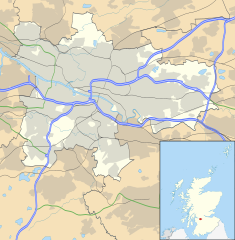Partick Police Station
| Partick Police Station | |
|---|---|
 The building in 2019 | |
| Location | Anderson Street, Partick |
| Coordinates | 55°52′11″N 4°18′20″W / 55.8697°N 4.3055°W |
| Built | 1853 |
| Architect | Charles Wilson |
| Architectural style(s) | Palazzo-style |
Listed Building – Category B | |
| Official name | 47 Anderson Street, 23 Gullane Street, Partick Police Station |
| Designated | 6 February 1989 |
| Reference no. | LB32845 |
Partick Police Station, previously known as Partick Police Court and also as the Old Burgh Hall, is a former municipal and judicial building on Anderson Street in Partick, Scotland. The building, which was previously the meeting place of the burgh council and now serves as the offices of the Centre for Sensory Impaired People, is a Category B listed building.[1]
History
[edit]Civic leaders in Partick decided to form a police burgh in 1852.[2] The new police commissioners immediately set about procuring a new meeting place: the site they selected was on the corner of Anderson Street and Wilson Street (now Gullane Street), just north of the River Kelvin.[3] The new building was designed by Charles Wilson in the Palazzo-style, built in ashlar stone and was completed in 1853.[4][5][6]
The design involved a symmetrical main frontage of five bays facing onto Anderson Street. The ground floor was rusticated and the central bay featured a round headed doorway with a fanlight, voussoirs and a keystone. On the first floor, there was a sash window, fronted by a balustrade, and enclosed in an aedicula, formed by pilasters supporting brackets and a triangular pediment. The other bays were fenestrated with round headed casement windows with voussoirs and keystones on the ground floor, and by sash windows flanked by pilasters supporting brackets and segmental pediments on the first floor. At roof level, there was a modillioned cornice. Internally, the principal rooms were the offices for the police constables, the police court and cells for the prisoners.[7]
The building continued to serve as the meeting place of the burgh commissioners until they relocated to the new Partick Burgh Hall in Burgh Hall Street in 1872.[8][9] Meanwhile, the old building in Anderson Street continued to operate as the local police station: a long single-storey cell block extending along Gullane Street was added in the late 19th century.[10] After Partick was annexed by Glasgow in 1912,[11][12] the building became the headquarters of 'L' (Partick) Division of the City of Glasgow Police and, after 'L' (Partick) Division merged with 'B' (Western) Division, it became the headquarters of 'B' (Marine) Division, which took on responsibility for policing the riverside quays and warehouses.[13]
The building played a central role in the investigations into the Bible John murders in the 1960s and then played a fictional role in the ITV television programme Taggart starring Mark McManus in the 1980s.[14] The building ceased serving as a police station when the police service relocated to a new headquarters in Dumbarton Road in 1993. Since then it has served as the offices of the Centre for Sensory Impaired People.[15] An extension to the southeast was designed in the modern style, built in yellow stone and completed in 2000.[16]
See also
[edit]References
[edit]- ^ Historic Environment Scotland. "47 Anderson Street, 23 Gullane Street, Partick Police Station (Category B Listed Building) (LB32845)". Retrieved 3 September 2024.
- ^ Greenhorne, William (1928). History of Partick 550–1912. John Thomlinson. pp. 137–138.
- ^ "Ordnance Survey Six-inch 1st edition, 1843–1882". Retrieved 3 September 2024.
- ^ "Partick Burgh Hall". Dictionary of Scottish Architects. Archived from the original on 8 March 2016.
- ^ Williamson, Elizabeth; Riches, Anne; Higgs, Malcolm. Glasgow (Buildings of Scotland Series). Yale University Press. p. 372. ISBN 978-0300096743.
- ^ Sinclair, Fiona (1995). Charles Wilson Architect, 1810–1863 A Question of Style. Park Circus Promotions. p. 23. ISBN 978-0952266716.
- ^ "Partick". The Glasgow Police Museum. Retrieved 3 September 2024.
- ^ Historic Environment Scotland. "3-9A (odd numbers) Burgh Hall Street, Burgh Halls (Category B Listed Building) (LB32852)". Retrieved 17 April 2020.
- ^ "Partick". Scotcities. Archived from the original on 2 June 2017.
- ^ Historic Environment Scotland. "Glasgow, 23, 25 Gullane Street, Partick Police Station (172156)". Canmore. Retrieved 3 September 2024.
- ^ "Partick Burgh Hall". The Glasgow Story. Retrieved 3 September 2024.
- ^ "How Glasgow annexed Govan and Partick 100 years ago". BBC. 7 August 2012. Retrieved 3 September 2024.
- ^ "Into the 20th Century". The Glasgow Police Museum. Retrieved 3 September 2024.
- ^ "Do you remember these Glasgow locations in Taggart?". Glasgow Times. 3 September 2023. Retrieved 3 September 2024.
- ^ "Glasgow City Council Sensory Services". Royal National Institute of Blind People. Retrieved 3 September 2024.
- ^ "Partick Police Court". Architecture Glasgow. Retrieved 3 September 2024.

